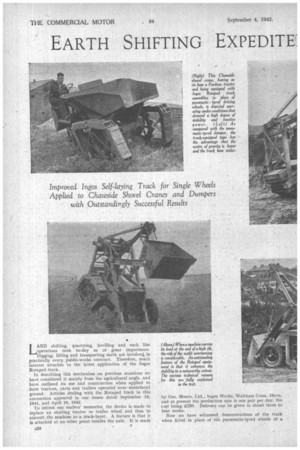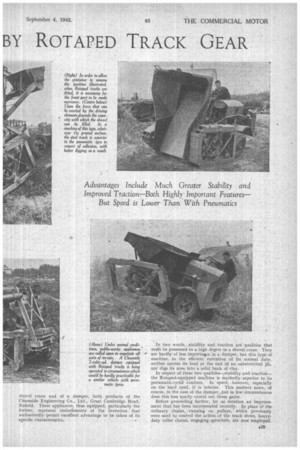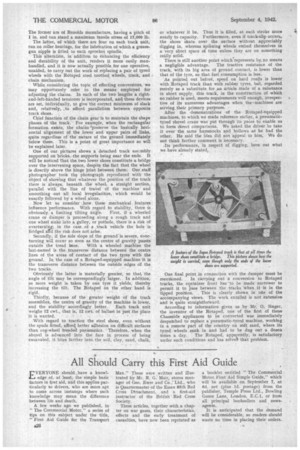EARTH SHIFTING EXPEDITE BY ROTAPED TRACK GEAR
Page 26

Page 27

Page 28

If you've noticed an error in this article please click here to report it so we can fix it.
• LAND shifting, quarrying, levelling and such like operations rank to-day as of great importance. Digging, lifting and transporting earth are involved, in practically every public-works contract. Therefore, much interest attaches to the latest application of the Ingos Rotaped track.
In describing this mechanism on previous occasions we have considered it mainly from the agricultural angle, and have outlined its use and construction when applied to farm tractors, carts and trailers operated over unsurfaced ground. Articles dealing with the Rotaped track in this connection appeared in our issues dated September 19, 1941, and April 10, 1942.
To refresh our readers' memories, the device is made to replace an ekisting tractor or trailer wheel and thus to convert the machine to a track-layer. A feature is that it is attached at no other point besides the axle. It is made
by Geo. Monro, Ltd., Ingos Works, Waltham Cross, Herts, and at present the production rate is one pair per day; the cost being £150. Delivery can be given in about three to four weeks.
Now we have witnessed demonstrations of the track when fitted in place of the pneumatic-tyred wheels of a shovel crane and of a dumper, both products of the Chaseside Engineering Co., Ltd., Great Cambridge Road, Enfield. These appliances, thus equipped, particularly the former, represent embodiments of the invention that undoubtedly permit excellent advantage to be taken of its specific characteristics. In two words, stability and traction are qualities that mutt be possessed to a high degree in a shovel crane. They are hardly of less importapce in a dumper, but this type of machine, in the efficient execution of its normal duty. neither carries its load at the end of an outstretched jib, nor digs its nose into a solid bank of clay.
In respect of these two qualities—stability and traction—. the Rotaped-equipped machine is markedly superior to its pneumatic-lyred confrere. In speed, however, especially on the hard road, it is inferior. This matters more, of course, in the case of the dumper, .but in few circumstances does this loss nearly cancel out those gains.
Before proceeding farther, let us mention an improvement that has been incorporated recently. In place of the ordinary chains, %running on pulleys, which previously were used to control the action of the track shoes, heavyduty roller chains, engaging sprockets, are now employed. The former are of Renolds Manufacture, baying a pitch of 1 in. and can stand a maximum tensile stress of 17,000 lb. The latter, of which there are four on each track unit, run on roller bearings, for the lubrication of which a grease
gun nipple is fitted to each sprocket spindle.
This alteration, in addition to enhancing the efficiency and durability of the unit, renders it more easily man handled, and it is now actually possible for one operative, unaided, to carry out the work of replacing a pair of tyred wheels with the Rotaped steel toothed wheels, track, and chain mechanism.
While considering the topic of effecting conversions, we may opportunely refer to the means employed for
adjusting the chains. In each of the two lengths a rightand-left-handed tensioner is incorporated, and these devices are set, individually, to give the correct minimum of slack and, relatively, to .afford parallelism between opposite
• track shoes.
Chief function of the chain gear is to maintain the shape phases of the track. For example, when the rectangular formation exists, the chains 'preserve the basically horizontal alignment of the lower and upper pairs of links, quite regardless of the nature of the ground immediately below them. This is a point of great importance as will be explained later.
One of our pictures shows a detached track ass:mbly supported on bricks, the supports being near the ends. It will be noticed that the two lower shoes constitute a bridge over the intervening space, despite the fact that the wheel is directly above the hinge joint between them: Our staff • photographer took the photograph reproduced with the object of showing that whatever the position of the track there is always, beneath the wheel, a straight section, parallel with the line of travel of the machine and smoothing out all local irregularities, which would be exactly followed by a wheel alone.
Now let us consider bow these mechanical features influence performance. With regard to stability, there is obviously a limiting tilting angle. First, if a wheeled crane or dumper is proceeding along a rough track and one wheel sinks into a gulley, or pothole, there is a risk of overturning; in the case of a ,track vehicle the hole is bridged ad the risk does not arise.
Secondly, if the side slope of the ground' is severe, overturning will occur so soon as the centre of gravity passes outside the tread base. With a wheeled machine the last-named is the transverse distance between the centre lines of the areas of contact of the two tyres with the ground. In the case of a Rotaped-equipped machine it is the transverse distance between the outside edges of the two tracks.
Obviously the latter is materially greater, so that, the angle of tilt may be correspondingly larger. In addition, as more weight is taken by one tyre it yields, thereby increasing the tilt. The Rotaped on the other hand is rigid.
Thirdly, because of the greater weight of the track assemblies, the centre of gravity of the machine is lower, and the stability' accordingly better. Each track unit
weighs 12 cwt., that is, 12 cwt. of ballast in just the place it is wanted.
With regard to traction the steel shoes, even without the spuds fitted, affor4 better adhesion on difficult surfaces than cog-wheel treaded pneumatics. Therefore, when the shovel is advanced into the face in process of being excavated, it bites farther into the soil, clay, sand, chalk, or whatever it be. Thus it is filled, at each stroke more nearly to capacity. Furthermore, even if track-slip occurs, the shoes skate over the surface without appreciably digging in, whereas spinning wheels embed themselves in a very short space of time unless they are on something really solid.
There is still another point which represents by. no means a negligible advantage. The tractive resistance of the track, with its big area of ground contact, is lower than that of the tyre, so that fuel consumption is less.
As pointed out before, speed on hard roads is lower with Rotaped track than with rubber tyres, hut, regarded merely as a substitute for an article made of a substance in short supply, this track, in the construction of which no rubber is used, meets requirements well enough, irrespective of its numerous advantages when the machines are serving.their primary purposes.
After the demonstrations of the Rotaped-equipped machines, to which we made reference earlier, a pneumatic. tyred shovel crane was put through its paces to enable us to form direct comparisons. We asked the driver to take it over the same hummocks and hollows as he had the other. He said the idea did not appeal to him,. We do not think further comment is necessary.
Its performance, in respect of digging, bore out what we have already stated, One final point in connection with the dumper must be mentioned. In carrying oat a conversion to Rotaped tracks, the container front has tohe made narrower to permit it to pass between the tracks When it is in the tipped position. This is clearly shown in one of the accompanying views. The work entailed is not extensive and is quite straightforward.
According to information given us by Mr. O. Singer, the inventor of the Rotaped, one of the first of these Chaseside appliances to be converted was immediately despatched to replace a pneurpatic-tyred machine, working in a remote part of the country on soft sand, where its tyred wheels sank in and had to be dug out a dozen
times a day. The Rotaped, apparently, is satisfactory under such conditions and has solve that problem.




















































